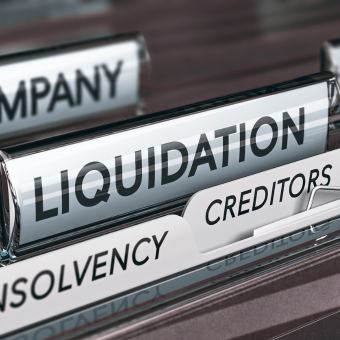

Legal insight
June 2025
Anna Virginia Poulimenou, LL.M.
Summary: This article examines the possibility of liquidating the bankruptcy estate through the sale of the business as a going concern, in accordance with the provisions of the Insolvency Code. It focuses on the procedure, the conditions required, and the deviations from the standard asset-by-asset liquidation process.
I. Bankruptcy Estate
Bankruptcy aims to satisfy creditors collectively by liquidating the
debtor’s assets. Law 4738/2020 decouples bankruptcy from commercial status,
meaning the bankruptcy estate now includes all movable and immovable property
of the bankrupt, regardless of whether they were part of a business.
Specifically, under Article 92(1) of L. 4738/2020, the “bankruptcy
estate” comprises all assets—movable, immovable, and the debtor’s
residence—owned on the date bankruptcy is declared. This includes rights,
intangible assets, trademarks, etc., acquired anywhere in the world before that
date. The estate also includes interest, periodic payments, ancillary claims,
and rights arising after the bankruptcy as long as they stem from
pre-bankruptcy legal relationships (Article 92(8)(b)). Excluded are those assets
specifically listed in the law, anything sold before declaration of bankruptcy
(subject to clawback rules), and assets acquired after bankruptcy. The debtor
may also use post-bankruptcy assets to satisfy bankruptcy creditors.
In personal bankruptcy, by exception, part of the debtor’s annual income
from the date of bankruptcy until discharge—above statutory thresholds—is
included in the estate. The law thus requires the bankrupt to “contribute”
excess income to the estate, preventing high-income debtors from avoiding
responsibility when they lack significant assets.
Upon the declaration, the debtor loses control of their property, which
passes to the trustee. Bankruptcy seizure serves the same purpose as the
special disposal prohibition under the Civil Procedure Code (“CPC”), but
ownership remains with the bankrupt until sale. The trustee manages the estate
and oversees liquidation, either as a whole or through individual asset sales,
assisted by bankruptcy bodies to maximize creditor satisfaction.
II. Individual Asset Sale Procedure
Law 4738/2020 provides a unified procedure for selling individual
assets—whether movable or immovable—when no organized business exists or if
it’s a very small enterprise under Article 2 of L. 4308/2014.
Examples include real estate, ships, aircrafts of any value, and movable
goods or groups thereof valued above €50,000. Items valued below that
threshold, per the trustee’s appraisal, may be sold in groups under the same
procedure. The law allows selling real estate with production units and their
annexes, or multiple functionally linked properties, to maximize value and
satisfy creditors.
The trustee administers the estate and manages sales. Secured creditors
have priority: they may carry out the sale of collateral themselves within nine
months following bankruptcy declaration. If they begin within this period, they
can proceed through to auction even after the nine months. “Commencement” means
initiating compulsory enforcement through seizure. If they do not act timely or
delay the process, the trustee regains sales authority. The same priority
applies to pledgees in possession of pledged movables.
III. Comparison with CPC Forced Auction Rules
The sale process largely mirrors CPC forced auction rules but with
adaptations for bankruptcy goals. Key
differences include:
·
Appointment of the auction officer (notary) is the first step, not
it being a judicial writ.
·
The trustee publishes a sale notice in the Insolvency Register instead
of a seizure report extract; no burden disclosure is required.
·
Within five days, this notice goes to the auction officer.
·
Auctions are held 30–45 days after publication, unlike CPC’s 7–8 month
timeline—reflecting a need for speed and recognition that the debtor has
already lost control.
·
There’s no requirement to publish on the e-auction site.
·
The trustee decides the order and grouping of sales and the starting
price, hiring two certified appraisers under L. 4152/2013. The starting price
is the average of both appraisals. In CPC auctions, a court-appointed bailiff
uses one appraiser and valuation may be challenged—no such challenge exists in
bankruptcy sales.
·
E‑auctions follow CPC rules (Article 163 of L. 4738/2020), with
bankruptcy-specific adjustments.
·
Article 163(14) requires a transfer contract be signed between the
trustee and the winning bidder—a clearer, more immediate transfer than CPC’s
delivery of an extract of award.
·
For unsuccessful auctions, an automated price-reduction mechanism
applies: within 20 days, a second auction occurs at ¾ of the average appraisal
value; if that fails, a third at ½. If still unsuccessful, the trustee
petitions the judge for further price reduction or alternative sale terms.
After 120 days, if unresolved, the trustee may proceed without a starting
price.
·
CPC rules on distribution of auction proceeds apply, with
“super-priority” for costs from previous restructuring or negotiation efforts.
·
Notably, there is no challenge allowed to execution acts in
bankruptcy auctions. The only allowed recourse is to contest the verified
claims list of the trustee via Article 933 CPC.
IV. Conclusion
The sale framework introduced by Law 4738/2020 seeks a balanced
approach: expediting liquidation while protecting creditor rights. It aligns
bankruptcy sales with CPC forced auction mechanisms but tailors
procedures—timeframes, pricing, vesting authority—to serve bankruptcy
objectives more efficiently. The lack of appeal against sale actions raises
concerns about due process, suggesting a possible gap that might be best
addressed by adapting CPC challenge provisions to bankruptcy proceedings.